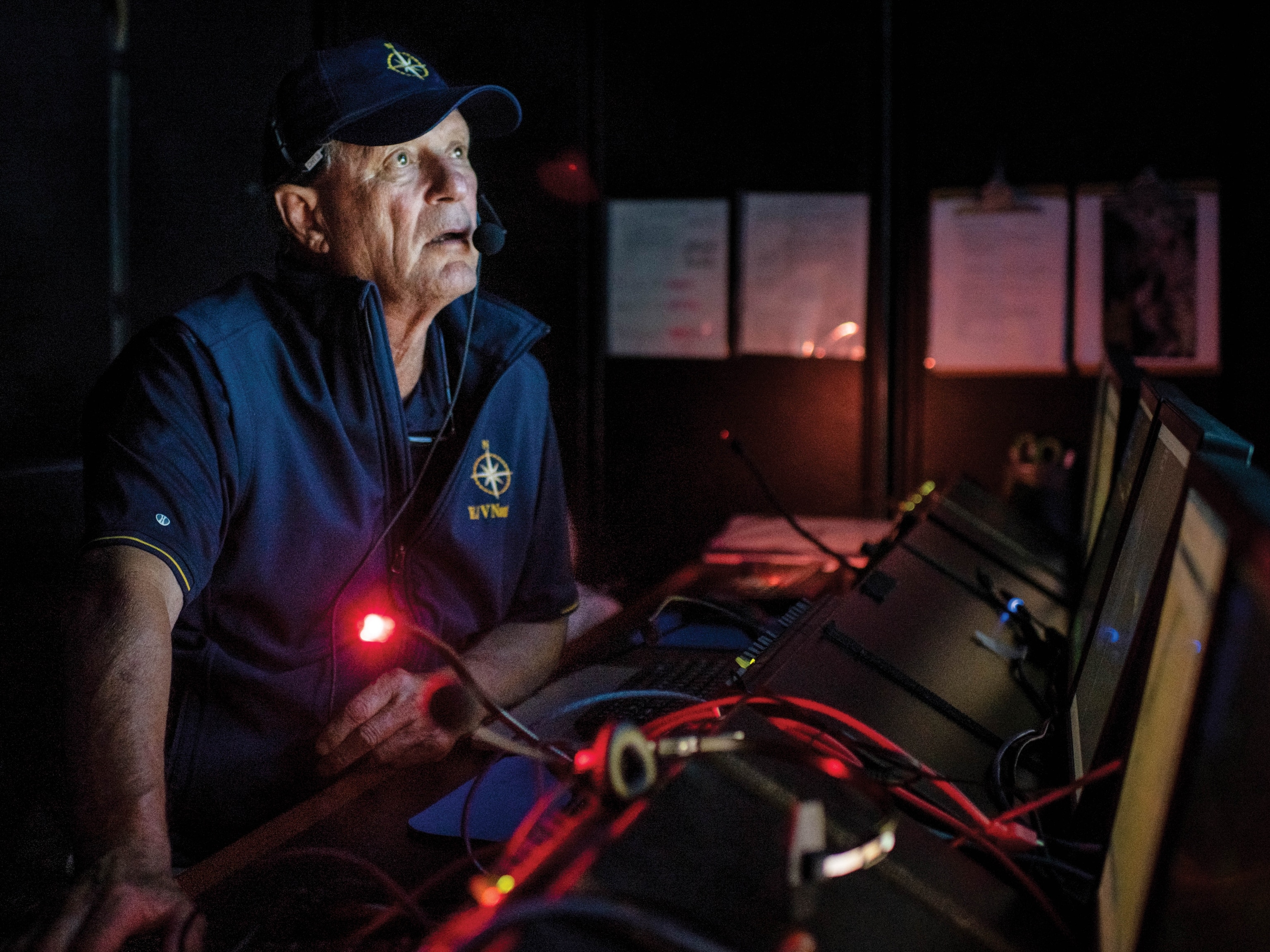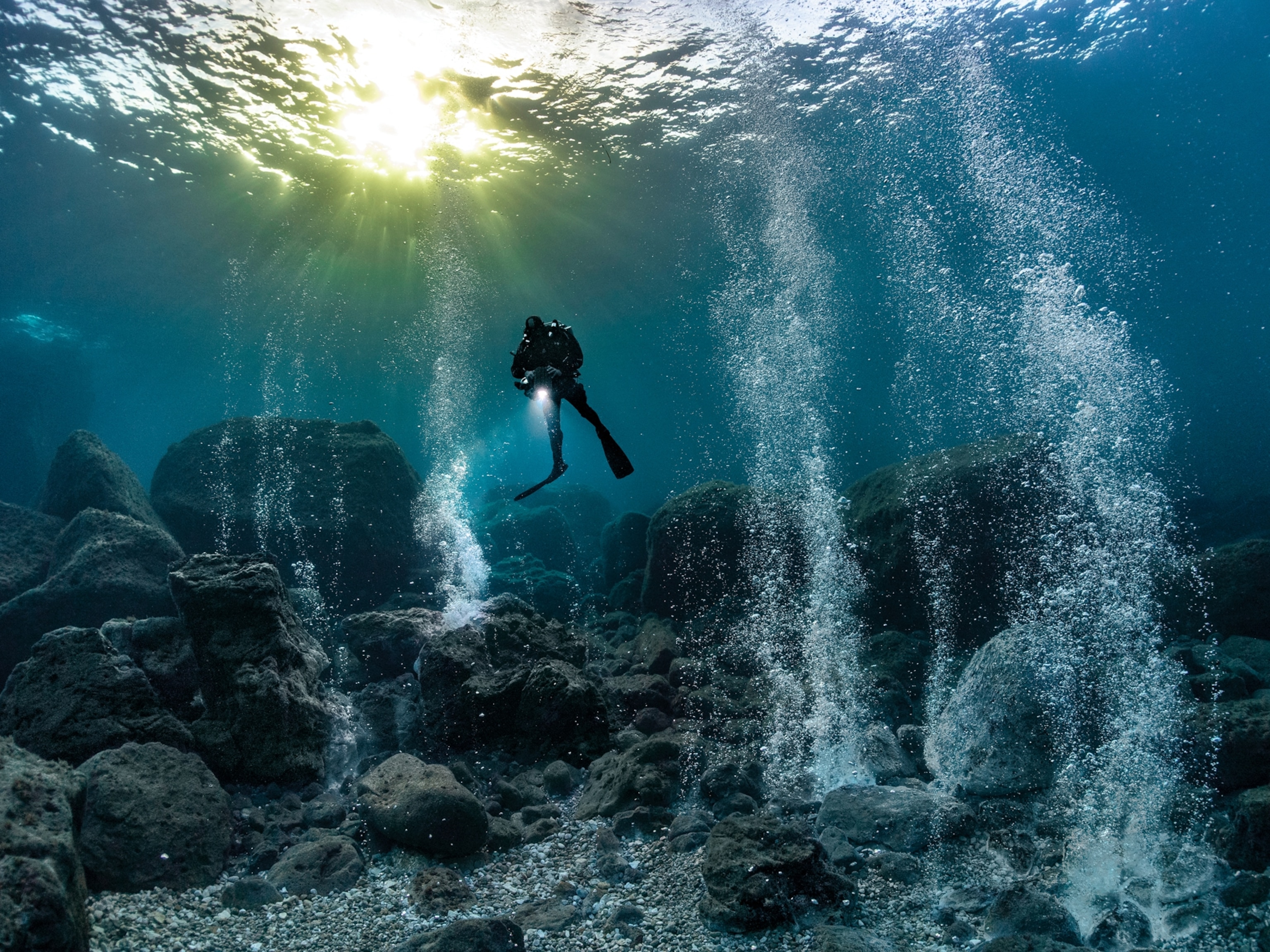5 ways Jacques Cousteau pushed to protect the planet
From advocating for coral reefs to blowing the whistle on nuclear dumping, the work of the legendary ocean explorer and conservationist is recognized in a new documentary.

Watch Becoming Cousteau, a National Geographic documentary currently playing in theaters.
At the 1992 United Nations Earth Summit in Rio de Janeiro, celebrities like Jane Fonda and Pelé mingled with the likes of the Dalai Lama and George Bush. But when it came time for presidents, prime ministers, and other world leaders to gather for an official photo, they only cared about one public figure. As they gathered for the photographer, the leaders clamored for the aging Jacques-Yves Cousteau to join them.
Dubbed “Captain Planet” at the event, the legendary French explorer, oceanographer, and advocate had come to ask leaders to recognize future generations’ right to enjoy an uncontaminated planet—responsibilities the UN eventually officially recognized. Nearly 30 years later, Jacques Cousteau is still remembered for his indelible contributions not just to the way people see the world, but to the environment itself. Here are five ways that he put the environment on the international agenda.

1. He opened up the underwater world
Cousteau is known as one of the fathers of scuba diving, which he helped pioneer in the mid-20th century. A former French naval pilot, Cousteau had become increasingly interested in ocean exploration. In 1943, as he searched for ways to make the depths more accessible to independent divers, he experimented with modifications to existing underwater breathing technology that would allow divers to stay below the surface longer without being tied to an air hose from a nearby ship.
The result was the demand regulator, or aqualung, which delivered air on demand at the correct pressure. The device freed divers from their ships and allowed them to spend time exploring beneath the surface. There, they encountered a vast new world that teemed with undiscovered life.
Scuba diving meant people could conduct scientific research, observe animals, clear mines, and even conduct archaeological expeditions under the sea. And the mystery he helped unlock continues: To date, an estimated 80 percent of the ocean has yet to be explored.

(Read about how Cousteau and the National Geographic Society explored the ocean together.)
2. He showed people why they should care about the ocean
Cousteau was fascinated by the idea of photographing under the ocean even as a teenager, when he began modifying and inventing photography equipment such as an underwater sled that enabled him to film on the ocean floor. After innovating scuba gear, he worked with Massachusetts Institute of Technology professor Harold Edgerton to create lighting suited to extreme underwater conditions. From strobe lights that illuminated deep-sea animals to lights that were able to penetrate deep water, Cousteau helped reveal what was below.
He also co-created the first true underwater camera, the Calypso. Named after his favorite ship, the 1961 camera could be used up to 600 feet underwater and was also viable above the surface. These and other innovations made it possible to take photos and even film movies underwater. Cousteau’s striking underwater images were showcased in National Geographic, which funded some of his early exploration.
Cousteau turned that medium into an art form with astonishing photography and influential films like The Silent World (1956), World Without Sun (1964), and Voyage to the Edge of the World (1977). The rise of underwater photography didn’t just benefit explorers and scientists—it helped the public understand the wonders of the ocean and feel invested in its conservation.
3. He advocated for oceans and coral reefs
Ongoing contact with marine creatures helped Cousteau switch focus from “adventure films,” as he called them, to advocating for all life in the sea. His seafaring life led to a deep appreciation of coral reefs and underwater plants and animals. Cousteau was among the first to document sonar in dolphins; he also discovered new species and even found previously unknown volcanic basins along the ocean floor.
Even though Cousteau served as a kind of ocean ambassador during his decades-long career, his record was blemished by accusations of early-career animal cruelty. In a biography of his father, Jean-Michel Cousteau wrote that the explorer used and killed captured sea creatures and treated others insensitively. In one of his films, Cousteau demonstrated dynamite fishing, a technique used by early divers in which dynamite is thrown into the water in an attempt to survey animal life in a particular region, by killing and bringing to the surface creatures that otherwise flee or hide from divers in the water.
Yet by the end of his life, Cousteau was warning that humans were depleting and ruining the oceans, threatening animals, and on the verge of destroying coral reefs. In 1974, he told ecologist Phil Dustan he suspected humans were causing coral reefs to degrade; his prediction turned out to be all too correct. Today, scientists say that humans are only a decade away from losing most of the world’s coral reefs to bleaching, human-caused climate change, and other factors.
4. He blew the whistle on nuclear waste dumping
As Cousteau spent more and more time underwater, he became concerned about world governments’ plans to dump nuclear waste into the world’s oceans and seas. In 1959, after hearing of the French government’s proposal to dump its nuclear waste in the Mediterranean, Cousteau engaged in a massive public information campaign and became a staunch opponent both of nuclear energy and the use of the world’s oceans as nuclear dumping zones.


Cousteau’s campaign to stop Mediterranean dumping succeeded, and he continued to advocate against ocean pollution through his foundation and through his books and public appearances. “We want the right of all people to decide on what risks they will or will not take, to protect the quality of life for future generations,” he wrote in a 1990 pamphlet.
5. He created a sense of responsibility for future generations
Cousteau’s ceaseless exploration of the world beneath the ocean surface led him to feel a sense of deep responsibility not just for the people and animals of his time, but for those of the future. In 1991, he began collecting signatures for a petition for the rights of future generations in hopes of pressuring the United Nations to modify its charter to include the rights of those yet to come to enjoy the natural world.
Cousteau ultimately gathered nine million signatures from around the world, and in 1997 the United Nations Educational, Scientific and Cultural Organization made a declaration on the responsibilities of present generations toward future ones that included language about environmental preservation and the responsibility to “bequeath to future generations an Earth which will not one day be irreversibly damaged by human activity.”
Cousteau spoke on those obligations at the UN conference he had attended in 1992. “Future generations would not forgive us for having deliberately spoiled their last opportunity,” he said. “Let us stop this delayed-action genocide! Let us cease thinking only of ourselves and reasoning only in the short term....This is our responsibility, as we hold in our hands the future of tomorrow’s exacting generations.”
Related Topics
You May Also Like
Go Further
Animals
- What would the world look like without mosquitoes?What would the world look like without mosquitoes?
- Social media loves to villainize dolphins. Here's why it's wrong.Social media loves to villainize dolphins. Here's why it's wrong.
- How did wolves evolve into dogs? New fossils provide cluesHow did wolves evolve into dogs? New fossils provide clues
- This unorthodox method is saving baby parrots from extinctionThis unorthodox method is saving baby parrots from extinction
- A deadly disease that affects cats big and small found in U.S.A deadly disease that affects cats big and small found in U.S.
Environment
- ‘Corn sweat’—and other weird weather phenomena—explained‘Corn sweat’—and other weird weather phenomena—explained
- A sea tornado sank a yacht. We might see them more often.A sea tornado sank a yacht. We might see them more often.
- How billions of dollars are revolutionizing ocean explorationHow billions of dollars are revolutionizing ocean exploration
- Where to go stargazing in Chile according to a local astronomer
- Paid Content
Where to go stargazing in Chile according to a local astronomer
History & Culture
- Did Babe Ruth really ‘call’ this legendary home run?Did Babe Ruth really ‘call’ this legendary home run?
- The real history behind the legend of China's Monkey KingThe real history behind the legend of China's Monkey King
- How new technology transformed the American workforceHow new technology transformed the American workforce
- This secret Civil War sabotage mission was doomed from the startThis secret Civil War sabotage mission was doomed from the start
- This rare burial site reveals secrets about the Sahara's lush pastThis rare burial site reveals secrets about the Sahara's lush past
Science
- Why some say tennis is 'the world's healthiest sport'Why some say tennis is 'the world's healthiest sport'
- Your body ages rapidly at 44 and 60. Here's how to prepare.Your body ages rapidly at 44 and 60. Here's how to prepare.
- How do gold nuggets form? Earthquakes may be the keyHow do gold nuggets form? Earthquakes may be the key
- Astronauts getting stuck in space is more common than you thinkAstronauts getting stuck in space is more common than you think
Travel
- These are the must-see sights of Italy's Veneto regionThese are the must-see sights of Italy's Veneto region
- A guide to St John's, Atlantic Canada's iceberg capitalA guide to St John's, Atlantic Canada's iceberg capital







